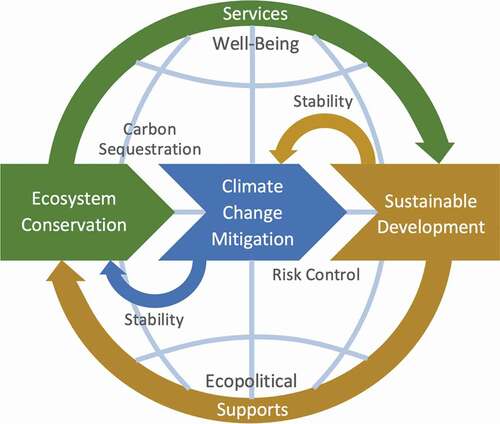The Glasgow Climate Pact from COP26 was aimed at turning the 2020s into a decade of climate action and support (https://unfccc.int). A total of 141 nations committed to work collectively to halt and reverse forest loss and land degradation by 2030 while delivering sustainable development (https://ukcop26.org/). The proposed efforts include the conservation of terrestrial ecosystems, promotion of sustainable development, enhancement of rural livelihoods, promotion of food security, sustainable forest management, and reversing of forest loss and degradation.
The successful execution of this worldwide commitment will result in a healthier, more productive, and larger forest coverage on Earth in a few years and thus, help achieve a balance between anthropogenic greenhouse gas emissions and removal by sinks. Ecosystem conservation, climate change mitigation, and sustainable development are closely interrelated, and can formulate interaction loops: improved ecosystem conservation helps enrich ecosystem services, including climate control; enriched and stabilized ecosystem services support sustainable development; and social and economic sustainability endows the improvement of ecosystem conservation (). The effectiveness of climate change mitigation plays a critical role in upholding the interaction loops because both successful ecosystem conservation and sustainable development depend on climate stability.
Figure 1. Interaction loops between ecosystem conservation, climate change, and sustainable development.

As climate change is posing a major threat to the progress of the sustainable development agenda (https://www.un.org/sustainabledevelopment/), transformed effort of ecosystem conservation is needed as part of climate action and sustainable development. The International Journal of Sustainable Development and World Ecology is aimed at promoting sustainable development that recognizes the balance of meeting development opportunities and conserving ecosystem services. To assist in realizing the 2030 forest conservation goal and beyond, the journal encourages the submissions of studies that advance our understanding of the maximum benefits of forest conservation for climate change mitigation and sustainable development. The journal is specifically interested in studies that focus on the following questions:
What are the risk factors to terrestrial ecosystem conservation, and how should the risks be managed?
What are the advantages of active management over complete protection of forest ecosystems?
What are the operational approaches to restore and protect terrestrial biodiversity at different spatiotemporal scales?
What are the challenges of using biomass as an energy source and how can the use of bioenergy be sustained?
What are the effective ecopolitical actions and technology innovations that promote sustainable forest protection, management, and utilization?
What are the international and regional collaborations to halt and reverse forest loss and land degradation on Earth, and enhance rural livelihoods?
What are the operational measures to maximize long-lasting forest carbon sequestration and stocking, and carbon storage in wood products?
What are the actual and potential roles of different terrestrial ecosystems in realizing and retaining carbon neutrality?
The International Journal of Sustainable Development and World Ecology is a dynamic forum for understanding and advancing the scientific consensus on sustainable development. The journal prioritizes papers that provide insights into the comprehensive answers to the question above. Starting with this editorial, the journal will bring published papers together as a Collection, titled Maximizing the benefits of forest conservation for climate change mitigation and sustainable development.
